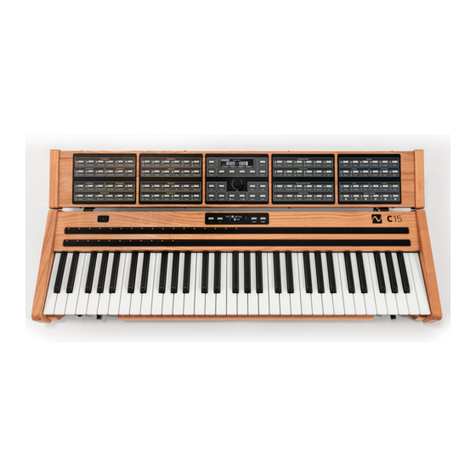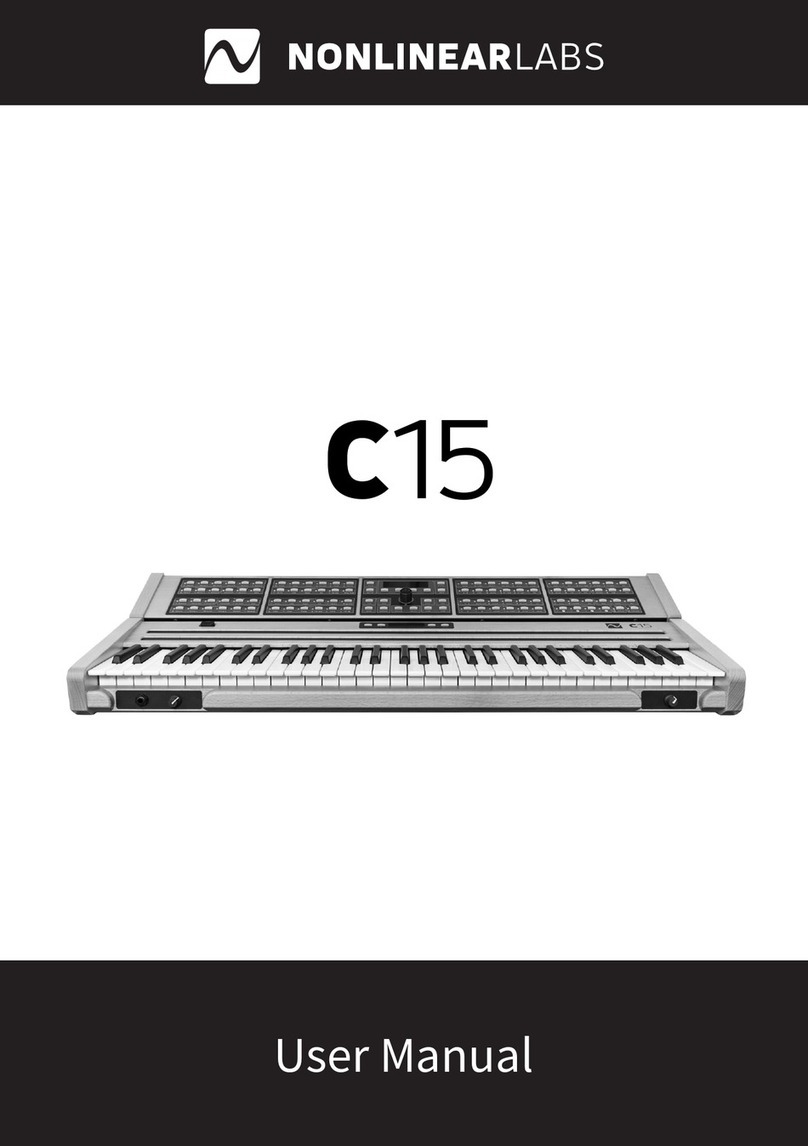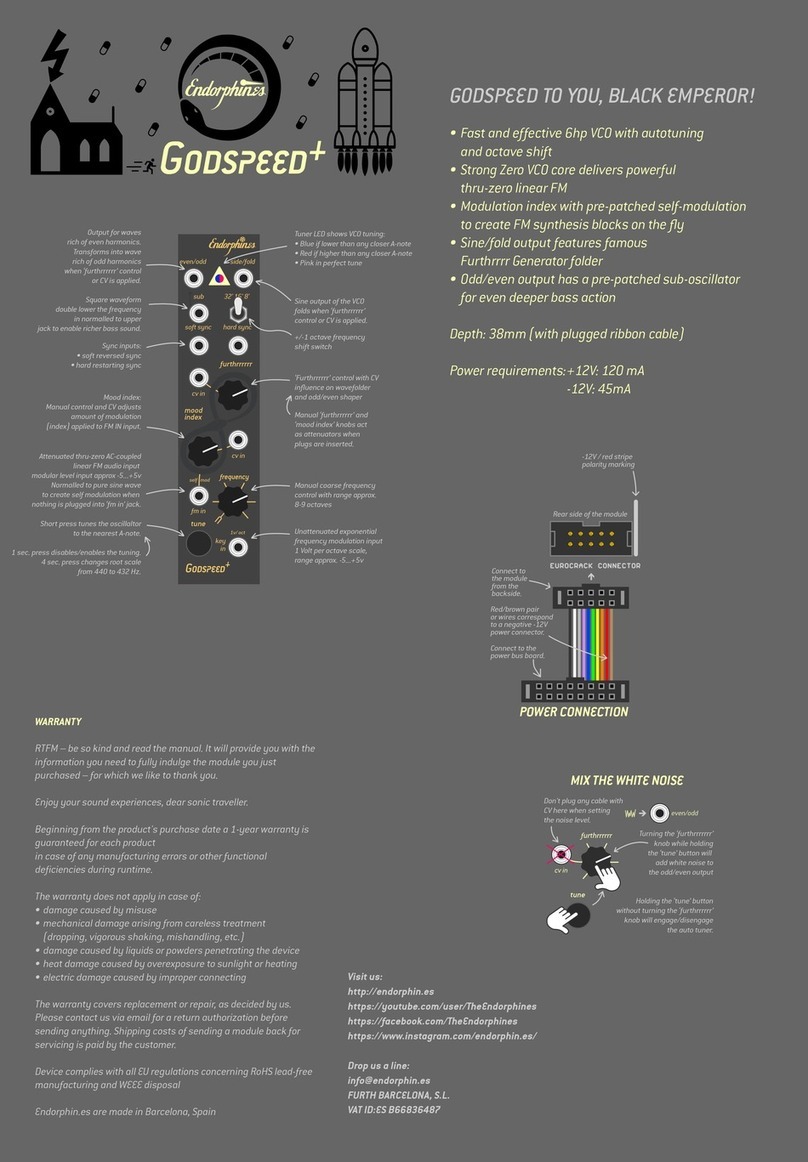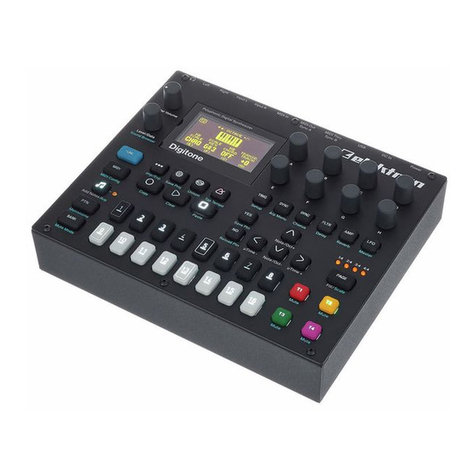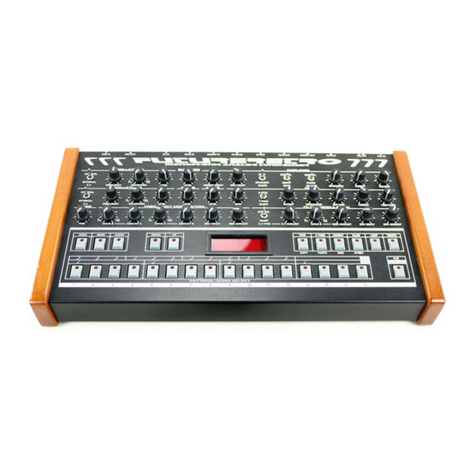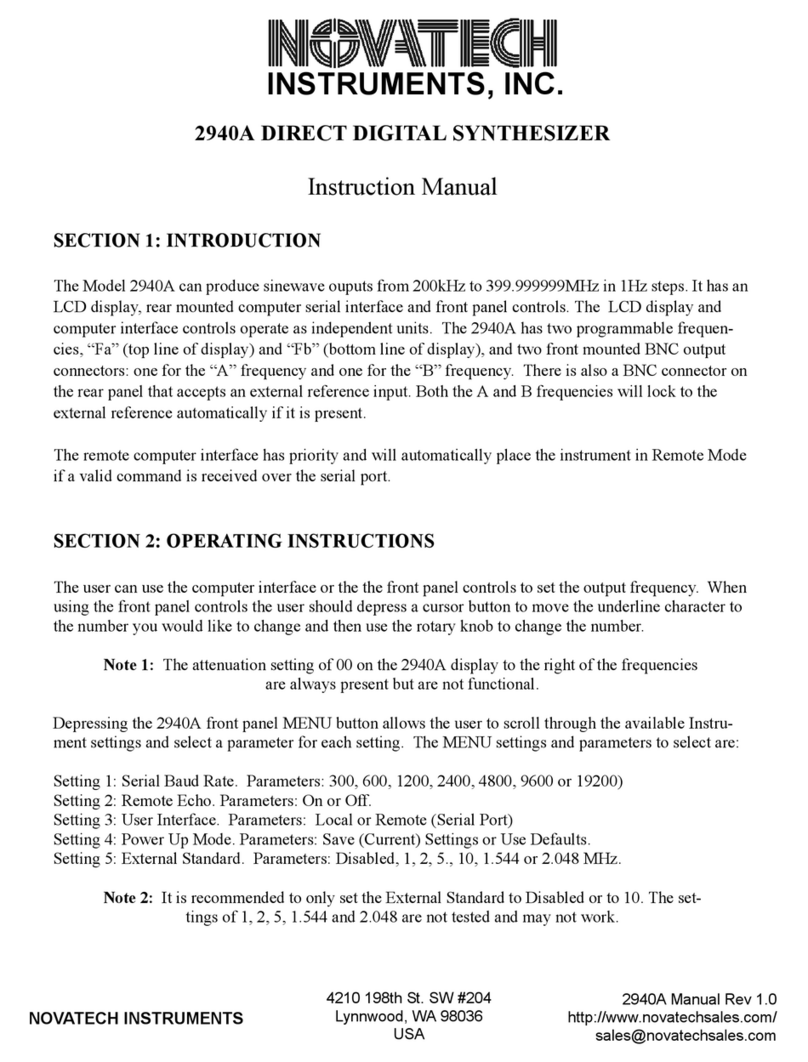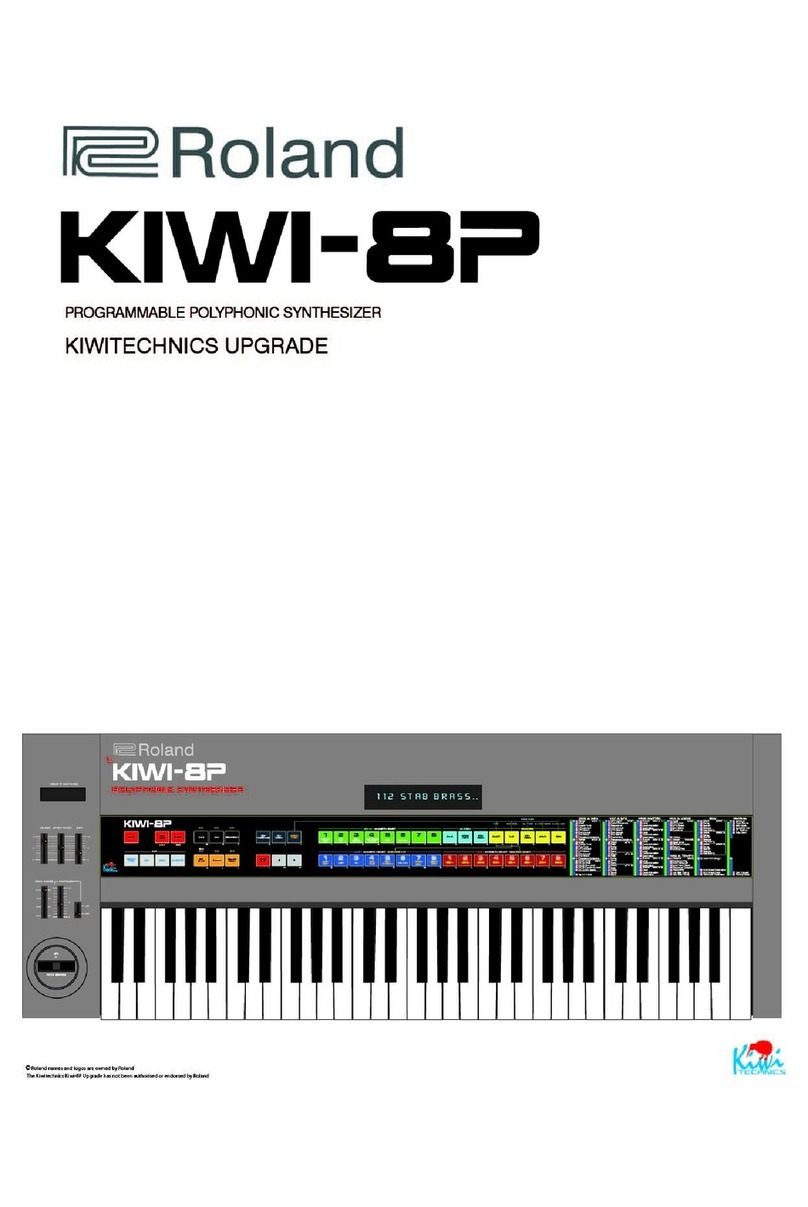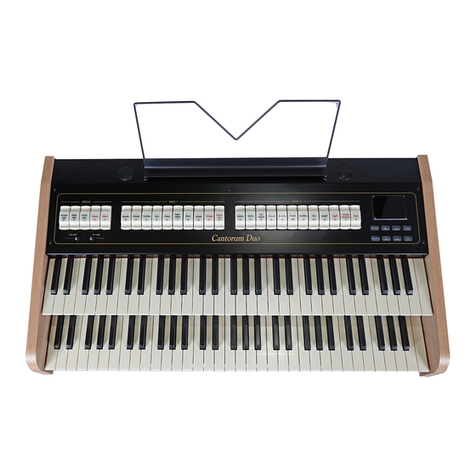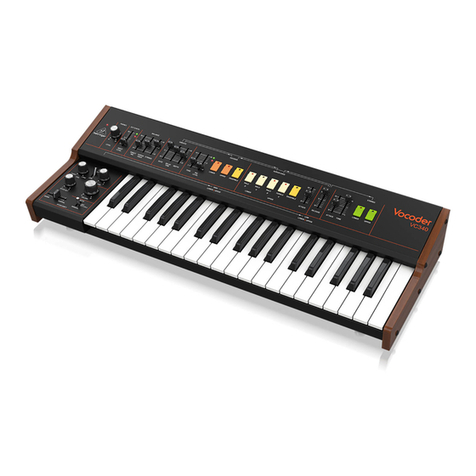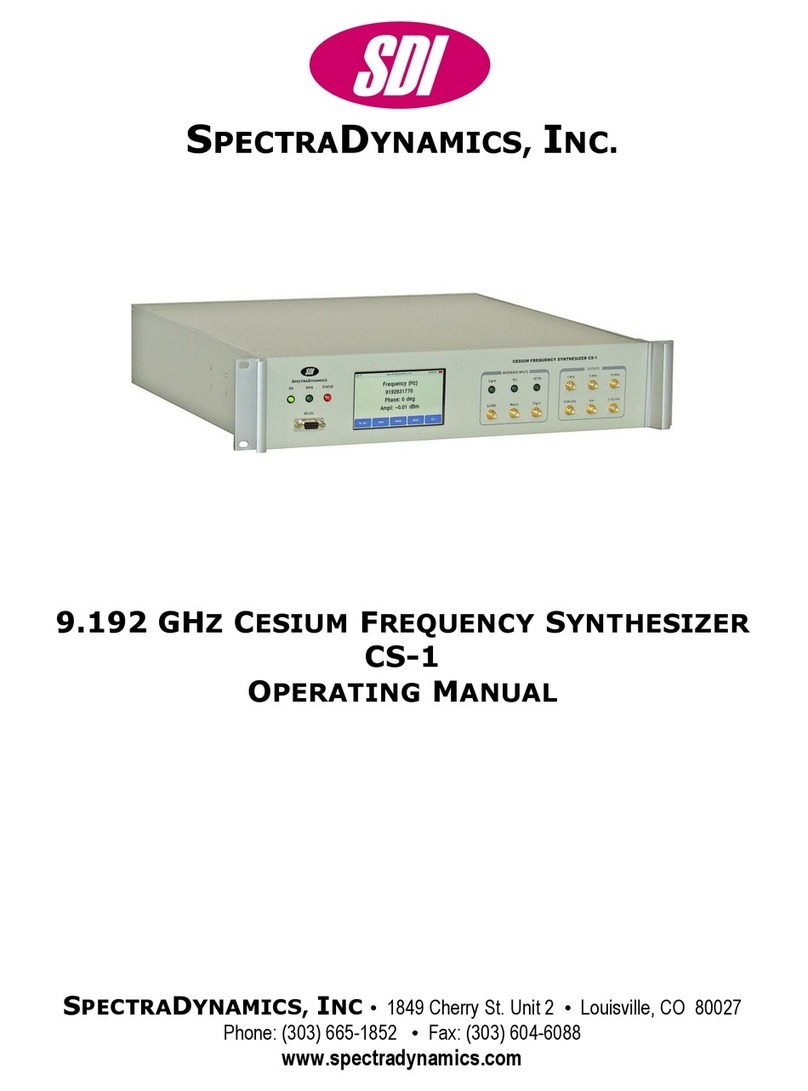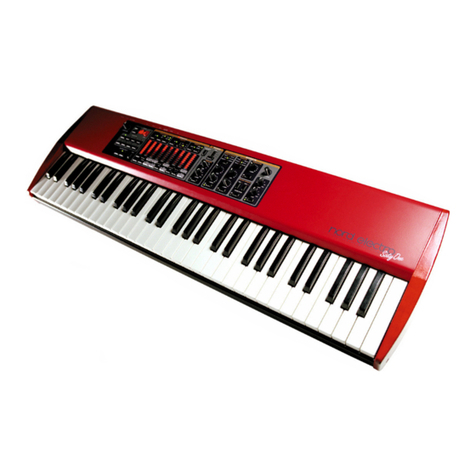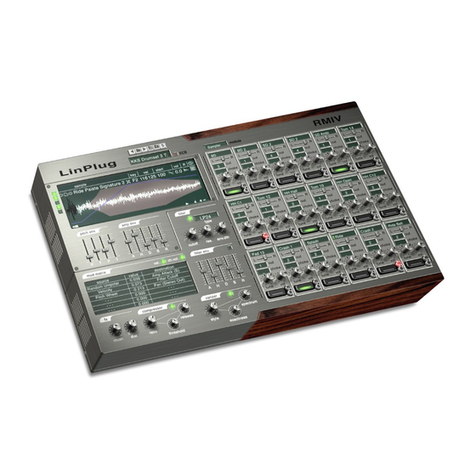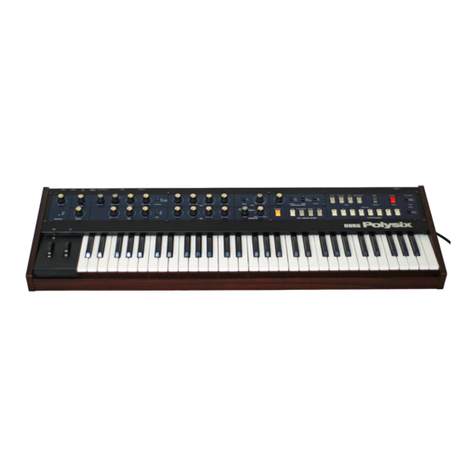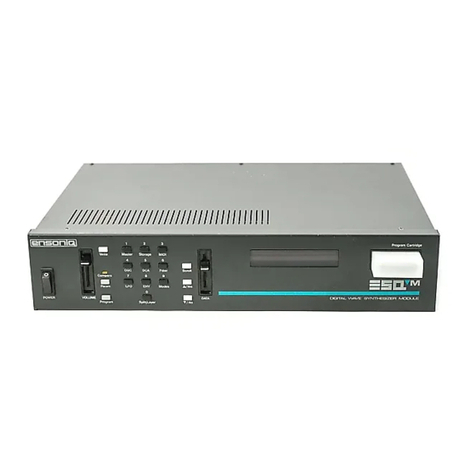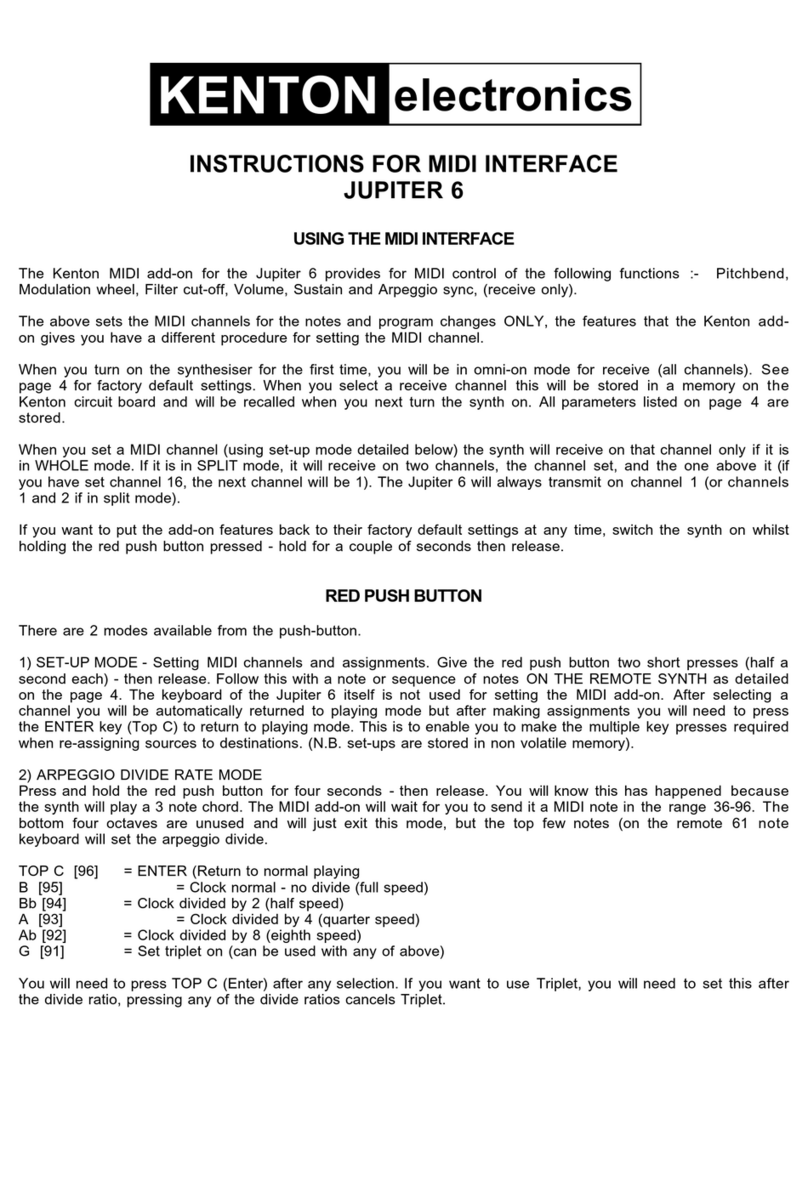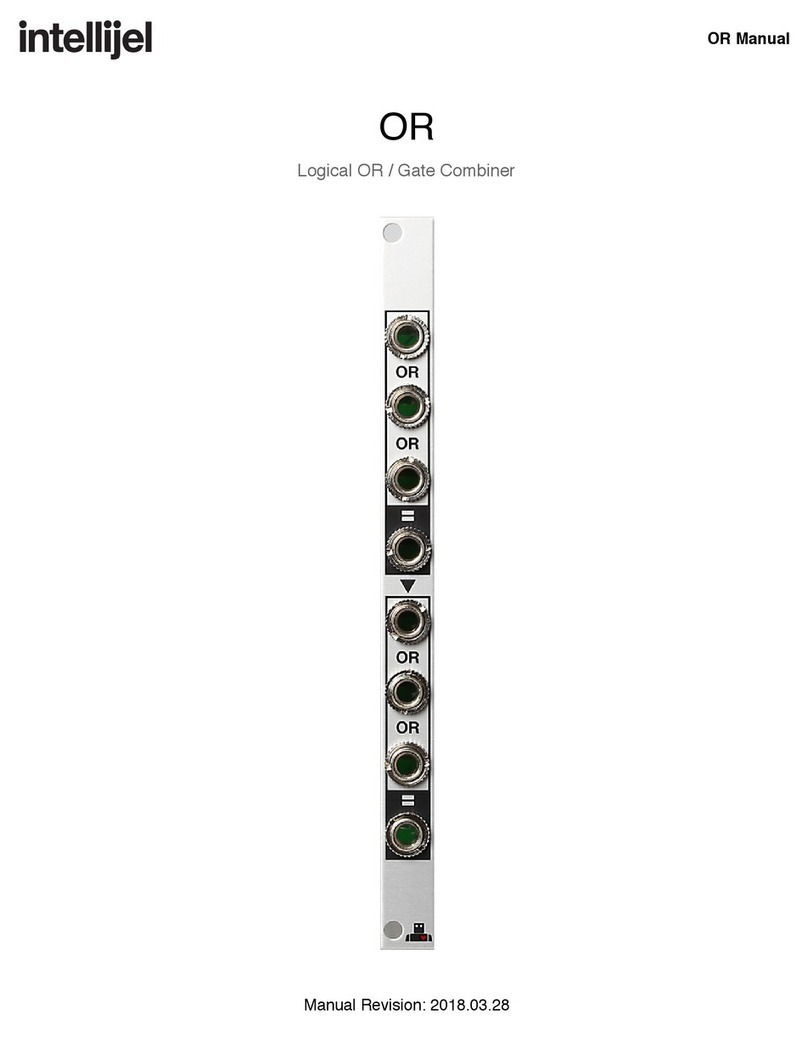NONLINEAR LABS C15 User manual

1
User Manual
C15 Studio Package - Addendum

Introduction
In the development of the C15 we first focused on human control and playability. We designed
a self-contained instrument "for those who love to play keys".
The implementation of a MIDI interface is now widening up the spectrum of applications for
the C15 - especially in the studio environment.
The second extension that is included in this soware release is an internal digital recorder. It
automatically stores the audio output signal of the last hours. Selected segments of the audio
can be downloaded in a lossless digital format. It also allows to restore the synth engine's
state at any point in time within the recorded audio.
The MIDI Implementation of the C15
Since the Studio Package update the C15 can receive and send MIDI messages. Received MIDI
messages can control the C15 and aect the sound, similar to playing the instrument itself.
When playing on the C15, MIDI messages can be sent, reflecting the performance. Note that
received MIDI messages will never be sent, so there is no "MIDI Thru" or loopback
functionality.
Receive and Send options include a Channel (Omni, 1 ... 16) specifier, filtering events
accordingly. When a Split Sound is loaded, a secondary (Split) Channel can be used in order to
separate both Parts from each other.
As classical MIDI operates on 7 bit resolution (128 steps), there is a loss in accuracy (the C15
operates on much higher precision). Nevertheless, precision can be maintained by enabling
"High Res." options. When enabled, the resolution increases to 14 bit (16384 steps). Values are
then encoded as a pair of MS (coarse) and LS (fine) components, eectively doubling the
amount of messages. This is still compatible with the classical resolution, as the LS
component is optional when receiving MIDI messages.
The C15 can send and receive MIDI messages for the following events:
Note On and Note O
When enabled, the C15 will produce sounds when receiving MIDI Note messages. Likewise, the
C15 will send MIDI Note messages when playing on the internal keybed, if enabled. Note On
and O velocities are supported and can optionally operate on high resolution, using an
additional MIDI CC (Control Change) message on Control Number 88, encoding the LS
component.
When a Split Sound is loaded, Notes can be received and sent on both Parts, using the
secondary (Split) Channel setting.
3

The eight Hardware ources
Physical control elements of the C15 like a pedal or the bender are called Hardware Sources.
They can be flexibly mapped to the Macro Controls, each of which can modulate up to 90
assignable parameters.
In the C15's user interface the Hardware Sources are represented by eight sliders. Their
positions can be sent and received via MIDI in the following way:
•Pedal 1/2/3/4 can be assigned to MIDI CCs 01...31 for the MS while CC 33...63 can work as
LS for 14 bit resolution. CC 64...69 can be assigned in a 2-state switching mode.
•Ribbon 1/2 can be assigned to MIDI CC 01...31 for the MS while CC 33...63 can work as LS
for 14 bit resolution.
•The ender can be assigned to MIDI Pitchbend or to MIDI CC 01...31 for the MS while CC
33...63 can work as LS for 14 bit resolution.
•Aertouch can be assigned to MIDI Channel Pressure or to MIDI CC 01...31 for the MS while
CC 33...63 can work as LS for 14 bit resolution, or to one half of the range of MIDI
Pitchbend (up or down).
Note that assignments are non-exclusive, so multiple Hardware Sources can be
bound to the same received MIDI message, as well as being merged into
indistinguishable MIDI messages when sent. This may be useful in certain scenarios,
so there are no restrictions. However, it is up to the user to find a meaningful setting,
apart from the provided default setting, consisting of distinct assignments.
When a Split Sound is loaded, Hardware Sources can be received and sent only on the primary
Channel. The secondary (Split) Channel setting does not apply for Hardware Sources.
Preset election
One of the Preset anks can be assigned to receive and send MIDI Program Changes. The
Program Change numbers are mapped to the first 128 presets of this ank.
MIDI Program Change messages are only received and sent according to the primary Channel
setting. The secondary (Split) Channel setting does not apply for Program Changes.
4

Connecting the C15 to a U B Device
The C15 has a Type A connector for US , and its embedded computer system works as a "US
host" for "US devices" connected to this port. This means that you only need a standard US
cable to set up a MIDI communication with an instrument, a hardware sequencer, or a MIDI
interface that has a US Type connector. You can connect the C15 to multiple US MIDI
devices via a US hub.
Important: The US port of the C15 can only supply a limited current to bus-powered devices.
Devices that have a higher power consumption need to be run with their own power supply, or
through a powered hub.
Connecting the C15 via 5-pole DIN Connectors
To use the classical MIDI cables and 5-pin DIN Ins and Outs a MIDI interface can be connected
as an US device directly to the US port of the C15. The most convenient and cost eective
solution are cables with integrated US -MIDI interface.
5

Connecting the C15 to a Computer
A computer running a DAW or similar is the center of many setups. It functions as a US host
and can only be connected to US devices. Since the C15 is also a US host we provide the
"MIDI ridge" that functions as a double-sided US device with two Type connectors. One of
the ports is connected to the C15 and the second to your computer.
Our adapter will appear as "NLL-MIDI- ridge" in the list of US MIDI devices. The two LEDs on
top of the box show the operation of the two US Ports. If both are lit in green color the box is
working normal. If one of the LEDs ist not green, the connection to its side is interrupted. More
information about the operation of the MIDI ridge can be found in the "MIDI- ridge-User-
Manual.pdf".
esides its function for the C15 the MIDI bridge can also be used for the MIDI connection
between other US hosts, like two computers.
6

MIDI ettings
In the Setup (both in the graphical UI and on the hardware) you find a new page for "Midi
Settings". It is divided into the sections "Receive", "Send", "Local", and "Mappings".
7

MIDI ettings: Receive
Channel
Here you can select the MIDI channel that is used to receive MIDI messages. With Split Sounds
it is the channel for Part I, and when "Split Channel Part II" is set to "Common" it will be used
also for Part II. If you select "Omni", messages from all 16 MIDI channels will be applied.
"None" will block all incoming MIDI messages, except in Split mode with Part II set to its own
channel.
8

plit Channel (Part II)
This setting applies to Split Sounds only. It controls the MIDI channel for Note messages
received by Part II. If you choose "Common", it is the same channel as it is set in the "Channel"
menu. If you select "Omni", messages from all 16 MIDI channels will be applied. "None" will
block all incoming MIDI messages for Part II.
If the channel for Part II is not set to "Common", the Split Point(s) are not applied to the
received MIDI notes. oth Parts can be played over the full MIDI note range.
Enable Program Change
When set to "O", the received MIDI Program Change messages will be ignored.
Enable Notes
When set to "O", the received MIDI Note On/O messages will be ignored.
Enable Hardware ources
When set to "O", the eight Hardware Sources will not be controlled by MIDI Control Change,
Pitchbend or Aertouch messages.
9

MIDI ettings: end
Channel
Here you can select the MIDI channel that is used to send MIDI messages. With Split Sounds it
is the channel for Part I, and when "Split Channel (Part II)" is set to "Common" it will be used
also for Part II. "None" will block all outgoing MIDI messages, except in Split mode with Part II
set to its own channel.
plit Channel (Part II)
This setting applies to Split Sounds only. It controls the MIDI send channel for notes played in
the key range of Part II. If you choose "Common", it is the same channel as it is set in the
"Channel" menu. "None" will block all outgoing MIDI messages for Part II.
Enable Program Change
When set to "O", MIDI Program Change messages will not be sent.
Enable Notes
When set to "O", MIDI Note On/O messages will not be sent.
10

Enable Hardware ources
When set to "O", the eight Hardware Sources will not generate MIDI Control Change,
Pitchbend or Channel Pressure messages.
MIDI ettings: Local
Enable Notes
When set to "O" the C15's keyboard is disconnected from the synth engine but still can be
used to send MIDI note messages.
Enable Hardware ources
When set to "O" the eight Hardware Sources are disconnected from the synth engine but still
can be used to send MIDI Control Change, Pitchbend or Channel Pressure messages.
(In this mode the user interface displays, e.g. the LEDs of the ribbons, do not reflect the current
positions of the Hardware Sources. This will be improved in a future update.)
11

MIDI ettings: Mappings
These settings determine which types and numbers of MIDI messages are assigned to the
Hardware Sources. High Resolution options for Velocities and Hardware Sources as well as a
ank selector for Program Changes are also provided. The Mappings apply to both MIDI Send
and MIDI Receive.
12

Pedal 1, 2, 3, 4
Each pedal can be assigned to a MIDI Control Change. The CC numbers 1 to 31 are available for
continuous operation in 7-bit and 14-bit (High-Res.) mode. In 14-bit mode a second CC with a
number between 33 and 63 is automatically assigned for the LS .
In addition, the CC numbers 64 to 69 are available. They work as 2-state switches, as it is
typical for e.g. a MIDI sustain pedal. When the C15's pedal position rises above 50 %, a MIDI CC
value of 127 is sent, when it falls below 50% a value of 0 is sent. A received MIDI CC value
smaller than 64 sets the pedal position to 0 %. Values of 64 or larger set the pedal position to
100 %.
y selecting "None" the pedal is disconnected from MIDI.
Ribbon 1, 2
Each ribbon can be assigned to a MIDI Control Change. The CC numbers 1 to 31 are available in
7-bit and 14-bit (High-Res) mode. In 14-bit mode a second CC with a number between 33 and
63 is automatically assigned for the LS .
y selecting "None" the ribbon is disconnected from MIDI.
Bender
In the typical application as a pitch bender the ender can be assigned to MIDI Pitchbend. This
has 14 bits resolution by definition.
The ender can also be assigned to a MIDI Control Change. The CC numbers 1 to 31 are
available in 7-bit and 14-bit (High-Res) mode. In 14-bit mode a second CC with a number
between 33 and 63 is automatically assigned for the LS .
y selecting "None" the ender is disconnected from MIDI.
Aertouch
The most common assignment would be MIDI Channel Pressure. This has only 7 bits of
resolution.
Aertouch can also be assigned to a MIDI Control Change. The CC numbers 1 to 31 are
available in 7-bit and 14-bit (High-Res) mode. In 14-bit mode a second CC with a number
between 33 and 63 is automatically assigned for the LS .
Two additional options are available to assign Aertouch to one half of the MIDI Pitchbend.
"Pitchbend up" has a range from the center to the maximum while "Pitchbend down" goes
from the center to the minimum. These ranges have 13 bits of resolution.
y selecting "None" Aertouch is disconnected from MIDI.
13

High-Res. Velocity (CC 88)
Note On and Note O velocities can be transmitted with a resolution of 14 bit by sending a CC
88 message before each Note On or Note O message. The value of the CC 88 represents the
LS that is providing additional 7 bits of resolution.
To avoid conflicts with other applications of CC 88, its use as velocity LS can be disabled
("O").
High-Res. CCs (use L B)
Control Changes can be transmitted with a resolution of 14 bit by using two CCs, one for
coarse (MS ) values and one for fine (LS ) values. The LS message has to be sent before the
MS message. The number of the CC for the LS is derived from the number of the CC for the
MS by adding 32.
To avoid conflicts with other applications of the LS CCs, their use can be disabled ("O"). This
setting applies to all assigned MIDI Control Changes.
Default Mappings
Classic MIDI High Resolution
Pedal 1 CC20 CC20 + CC52 (MS + LS )
Pedal 2 CC21 CC21 + CC53 (MS + LS )
Pedal 3 CC22 CC22 + CC54 (MS + LS )
Pedal 4 CC23 CC23 + CC55 (MS + LS )
Ribbon 1 CC24 CC24 + CC56 (MS + LS )
Ribbon 2 CC25 CC25 + CC57 (MS + LS )
ender MIDI Pitchbend MIDI Pitchbend
Aertouch MIDI Channel Pressure CC26 + CC58 (MS + LS )
High-Res. Velocity (CC88) O On
High-Res. CCs (use LS s) O On
14

Choosing a Bank for MIDI Program Change:
To make use of MIDI Program Change messages one of the C15's preset banks has to be
assigned as the source and target of Program Changes. A received Program Change would
select the preset with the referring number in this bank and the selection of a new preset in
the bank will send a MIDI Program Change with its number. Selecting a preset that has a higher
number than 128 will not send a Program Change.
The "Direct Load" switch decides if the C15 only sends a MIDI Program Change when you
select a preset, or if the preset is also loaded into the sound engine. Therefore it has a similar
eect like a "Local O" for Program Changes.
The header of the MIDI-assigned bank is marked by a symbol that looks like a 5-pole MIDI
connector. The bank can be connected or disconnected in the following ways:
•In the graphical UI you find the entry "Connect ank to MIDI PC" or "Disconnect ank from
MIDI PC" in the context menu of the bank header.
•In the Preset Screen of the Hardware UI activate the " ank" focus by pressing the So
utton 1 (with a dual preset hold the button for a second). In the "Edit" menu you find the
entry "MIDI PC: On" or "MIDI PC: O", that can be toggled by the "Enter" button.
y connecting a bank to MIDI PC the previously connected bank will be disconnected. Aer
disconnecting the currently connected bank, none of the banks will be connected. The
currently assigned bank can also be found and changed in the "Program Change ank" menu
in the MIDI Settings.
15

The Digital Audio Recorder
General Function
The internal recorder enables you to capture the C15's output signal with the best possible
audio quality at any time, without connecting a soundcard.
The stereo signal behind the So Clipper and before the D/A converter is written to the RAM,
using the lossless compression of the FLAC format (24 bits, 48 kHz).
A maximum of 500 M can be stored in the RAM. ecause of the FLAC compression this is
enough for hours of permanent playing and for days of recording when there are pauses in the
playing.
If the recorded amount of data exceeds the limit of 500 M , the oldest data will be overwritten.
Therefore it works like a ring buer that always contains the latest recording.
The content of the RAM will be lost, when you switch o the C15. You can select a segment of
the recorded audio and download it to your computer to use it in your production
environment.
16

Recorder ettings - Auto- tart
In the Setup you find a new page for "Recorder" settings. With the option "Auto-Start
Recorder" the user can decide if the audio recording starts automatically when the C15 is
switched on, or if the user has to start it by the Record button.
User Interface
The Recorder tab can be opened by the "Open Recorder" entry in the "View" menu.
(The tab has the address http://192.168.8.2/NonMaps/recorder/index.html)
The recorder works independent from its browser tab being open or not.
17

Zoom and croll
At the bottom of the recorder display you find a dark stripe representing the whole length of
the audio recording that is in the memory. It is the frame for a bar that is used for scrolling and
zooming. y holding the bar in its grey center area and dragging it, you shi the visible section
of the recorded audio, which means that the display content is scrolled. y the two handles at
the ends of the bar you can change its length and therefore the zoom factor.
The two buttons with magnifier "+" and "-" icons and the mouse wheel can also be used to
zoom in and out.
Control Buttons
Restore - Play/Pause - Record - Download - Delete
Computer Keyboard hortcuts
Command Shortcut
Play / Pause space bar
Record R
Restore Z
Download S
Zoom In / Out + / -
Scroll le / right arrow keys
To Previous/Next Preset Marker up / down arrow keys (coming soon)
18

Playing Back Recorded Audio
The C15 can play back the recorded audio through its outputs. The playback start position is
set by a click/touch in the darker outer lanes of the recorder display. A green line - the Play
cursor - shows the position. A time label is attached.
When the Play button is pressed, the Play cursor starts to move and the recorded audio is
played back. The button gets a "Pause" symbol and can be used to interrupt and continue the
playback. Alternatively you can press the space bar for toggling between Play and Pause.
You can play the C15 live while the playback is running, but please be aware that the sum of
the two signals can cause clipping distortion.
19

Restoring a ound
The Undo system of the C15 memorizes every user action on parameters or presets. It allows
to go back to the state of the synth engine at any point in time since the start of the session.
Therefore it is possible to restore the sound at a certain position on the timeline of the
Recorder and to use the same state of the synth engine as it was at the time of recording.
For this you move the Play cursor to the point in time of which you want to restore the sound
and press the Restore button or the Z key on your keyboard. The Undo System will go back to
the state of the parameters at the selected point in time, takes a "snapshot" of them and
copies it into the editbuer.
Preset Labels
Please note that the selection and load status of a preset cannot be restored because the
preset might have been changed, moved or deleted.
In order to not loose the information which presets were used, the Recorder creates a label
when a preset is loaded. The le end of the label is aligned to the loading time. The label
contains the number and name of the bank and the preset. This might have changed in the
meantime, but oen it can still be found under the same name at the same place.
To be on the safe side we recommend to create copies of the banks that contain important
presets by using the "Export" command.
20
Other manuals for C15
14
Other NONLINEAR LABS Synthesizer manuals

